Llano in the Wild: Toshiba's Satellite L775D-S7206
by Dustin Sklavos on August 12, 2011 12:45 AM ESTSeventeen Inches of Mediocrity
The more notebooks I review, the more I find that the bog standard resolutions available for many of these form factors just aren't enough. 1366x768 in a 15.6" notebook borders on offensive, but 1600x900 at 17.3" really isn't a walk in the park either. The overall resolution is an improvement from the 1440x900 that old 17" notebooks used to run at, but dot pitch is still high. It seems like if you want a good screen, you need to find a notebook that supports 1080p.
Toshiba's Satellite L775D-S7206 sports a middling 17.3", LED-backlit 1600x900 screen that's serviceable but as you'll see, utterly unexciting. This is to be expected given the price tag and resulting market the notebook is aimed at.
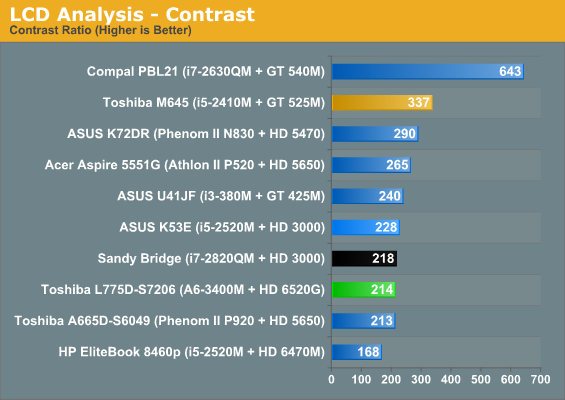
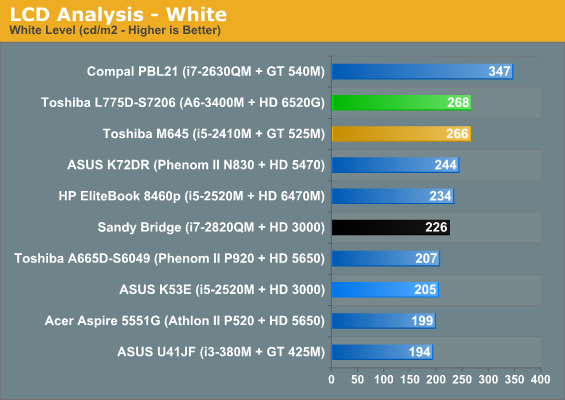

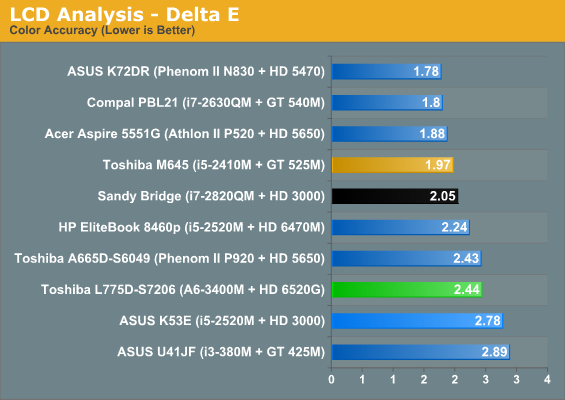
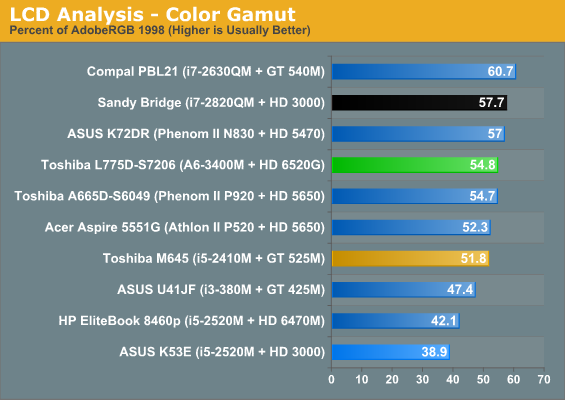
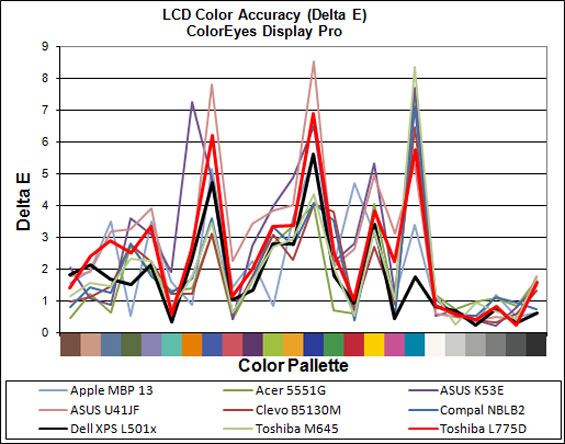

Poor black levels keep the Satellite's Samsung panel from achieving a decent contrast ratio, and while the color gamut is alright, accuracy is in the toilet. Overall the screen is bright enough, but we're most definitely in budget laptop territory.
Viewing angles don't fare much better. This is a TN panel through and through and while notebooks like the substantially more expensive Alienware M17x R3 prove TN panels don't have to suck, it's still frustrating to see technology this mediocre continuing to run wild.















74 Comments
View All Comments
Rookierookie - Friday, August 12, 2011 - link
Pricing this at $699 brings this into competition with the Dell XPS 15, which starts at $799 with i5-2410M and a Nvidia GT 525M. You trade off on some utilities, but it's basically a much faster laptop for about $100 more.At $599 this becomes a much more attractive option.
nitrousoxide - Friday, August 12, 2011 - link
No, for that $100 you can get an SSD. And it feels "much faster" than the XPS 15 with HDD.prdola0 - Friday, August 12, 2011 - link
SSD with usable size for $100? No. Not really. XPS 15 is a much better choice.JGabriel - Friday, August 12, 2011 - link
Dustin Sklavos @ Top: "I do honestly think two faster AMD cores would've been a better call than four slow cores"
For low-end home users, the most common problem I've seen is thread clutter. We're talking about people who aren't very tech literate, and load up their machines with tons of little tech gewgaws to tell them the weather, list headlines, perform animations when they get mail, make their mouse cursor "cute", and so on.
I suspect this is one of AMD's target markets for Llano. If so, one can see the argument in favor of more slow cores over few fewer fast ones. These are people who don't need to get anything done quickly, they just need a lot of low-demand things done simultaneously.
jfelano - Monday, August 15, 2011 - link
It will be $599ckryan - Friday, August 12, 2011 - link
The contrast ratio chart shows that laptop screens are usually not very good. Not that its newsworthy, but how do manufacturers expect to keep selling even midrange laptops when you can get a tablet with a bitchin screen and better battery life. Not that the two devices roles are interchangeable for many tasks, but I for one won't be buying another laptop until screens get better.damianrobertjones - Friday, August 12, 2011 - link
It is a shame that the Radiance (HP Envy line) screen maker went out of business! madnessLordConrad - Friday, August 12, 2011 - link
As someone who wears glasses, I personally like my screens with a slightly lower resolution because everything is natively larger. I know you can adjust font and icon sizes in Windows, or simply change the resolution, but I consider these changes to be a last resort option. I loved my last HP dv7 laptop, it was a bit bulky but it had a beautiful 1440x900 screen that was just right for my eyesight. My current laptop is a slightly smaller and less bulky dv6 with a 1366x768 screen, which is also perfect for my eyesight. With both laptops I had the option to get a higher resolution screen, which they probably don't include on the review systems you get.Just keep in mind that not everyone has 20/20 (or better) vision.
Dustin Sklavos - Friday, August 12, 2011 - link
Actually my eyesight is pretty dire, too.The thing is, high resolution screens seem to tend to produce better color, better contrast, and better viewing angles. I'd take one of those at a lower-than-native resolution at this point, just because they LOOK better.
ckryan - Friday, August 12, 2011 - link
My eyesight is pretty good, and I no longer prefer maximum DPI. A 1920X1200 display is great at 24", but in a 15" laptop it's definitely not for everyone. I told a family member not to get one as an upgrade in a Dell Vostro a couple years ago; She runs it at half the native resolution. It is a pretty good TN screen, much better than the other options, but just way to fine pitched. I'm to the point where I will happily take a better panel display at a lower res than a much higher TN panel. It would be different if WIndows was better about scaling, but you can only do so much by adjusting DPI display settings.Still, I'm pretty serious about not buying another laptop until I can get a display in the style to which I'm accustomed these days. Whenever I pick up my laptop I die a little on the inside. The viewing angles are terrible, black level is absurdly high, contrast is low, and this is the upgraded panel in the Dell D630 14" I'm using. At least I have the docking bay for it.